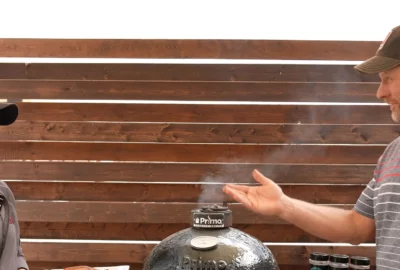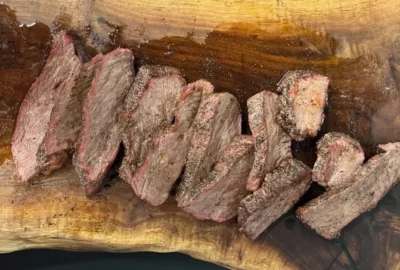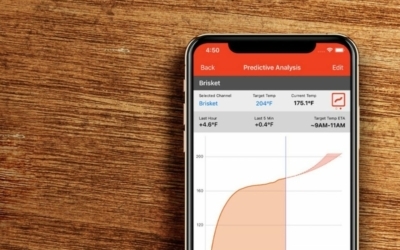Smoking & Grilling World
Upgrading an Old Grill with FireBoard Tech

A FireBoard 2 Pro with Blower Drive maintaining 250ºF on our WSM purchased off of Craig’s List.
With Memorial Day behind us, the summer grilling season is well underway. Many of FireBoard’s products are the perfect instrument for large-scale commercial-grade smokers commonly seen at BBQ competitions. And it is easy to see why. With the ability to run up to 6 probes per unit, this gives cooks the ability to monitor multiple proteins all from the convenience of the FireBoard App.

FireBoard sells an easy-to-install adapter kit to retrofit their Drive Blower fan on your old Weber grill. This allows you to create temperature control programs for smokers and grills that were made years ago. Giving new life to an old favorite.
After spending an afternoon talking with many BBQ enthusiasts at Scheels’ Grill Fest last weekend, I learned that those interested in getting started in smoking felt that they needed an expensive dedicated smoker. The reality is that smoking can be done with a variety of cookers, even those that were not originally designed for the purpose of slow cooking. Plus you can easily source a used one from Craig’s List or your local Facebook Marketplace. In fact, the chances are very good that you know someone with one in their basement just waiting for you, so ask around.

If you are interested in getting an affordable smoker with a FireBoard Drive, the secondary market will have many candidates waiting for you.
These icons of outdoor cooking, have been made for decades and are perfect for a FireBoard upgrade. I used two of them in my blog comparing lump and briquette charcoal.

A Weber Kettle grill smoking chicken thighs, via an offset coal placement and FireBoard Drive upgrade.
Further, the design is perfect for adding a FireBoard 2 Drive and Blower. Doing this will unlock temperature control, and app-based monitoring capabilities, not to mention all of the features associated with a FireBoard Drive setup.
Almost as ubiquitous as the Weber Kettle is a smoker that Weber put together called the Weber Smokey Mountain a.k.a. WSM. Poke around in your go-to BBQ forum and there will be a thread about this beginner’s favorite. I found one on Craig’s List and picked it up to add to the FireBoard research collection of cookers.
Indirect Heat
Step one in smoking with a grill is to alter the direct path between the coals and your food. With selective heat in mind, Weber designed their Char-Baskets to corral charcoal on one side of the grill, creating indirect heating. With all of your heating coals on one side of the grill, placing your food in a pan on the opposite side gives indirect heat that permits the slow-and-low cooking conditions necessary for some smokey meat. Designed as a smoker, the WSM has a heat deflector as part ot the design.

The Weber Char-Basket in action smoking some chicken thighs. Kettle-inspired grilling artwork provided by Edison Skelton.
Fan Control
Adding a Fan to the air intake of any charcoal or wood-burning grill adds oxygen to a fire increasing heat, like a bellows. The FireBoard Drive Blower ships with adapter plates for a variety of grills. They also sell adaptors for specialty applications like ball valve controllers seen on gravity smokers and the Nozzle Adaptor. The high temp safe rubber gaskets conform to the curvature of cookers like the Kettle and WSM. Plus the interior outlet allows you to control the direction of the air common into the firebox.
Drive-compatible FireBoard models follow a PID algorithm when pit temp is set or a Drive Program is selected. Drive Programs allow FireBoard users set their cookers to run at a chosen temperature for a time duration or until a desired inter temperature is reached, as reported by a food probe. All of this can be easily done on either the FireBoard App or on the device itself, check out this previous blog for more information on Drive Programming.
Installation
To install the FireBoard Nozzle Adaptor, a 1” hole will need to be drilled into the side of the cooker. This hole should be above the charcoal line but not interfere with other parts of the grill like lower vent operation or grate brackets, see photos for an idea of a good location. With your hole cut, mount the padded portion of the Nozzle Adaptor to the Blower using the silver prongs and knurled set screws. Then while holding on the fan against the hole, thread the long machine screw through the square-shaped nozzle head and into the body of the fan. Be sure to keep the output of the fan centered on the hole, and tighten the long machine screw with the nozzle directing air downward.

If you don’t want to drill a hole in your WSM, you can mount the fan through one of the circular vent holes on the smoker. Two things to keep in mind when going this route. First, this pre-existing vent hole is smaller than the recommended 1” and will not be able to provide as much air to control the fire. Second, you will need to block the airflow of the other three holes on that circle vent. We have used HVAC quality heavy gauge foil tape. This works nicely for sealing up other areas where air can get into your grill.

Installing a FireBoard Drive Blower fan on a Weber Smokey Mountain is ideally accomplished by drilling a 1″ hole in the grill. Alternatively, there is a no-drill method as seen above.
Test Run
To demonstrate the Drive at work, I decided to run a test burn with our newly converted Weber Smokey Mountain. With high hopes of breaking an inner-office record of 16 hours, I added a level basket of Kingsford Briquettes. The weight of the briquettes was 11 pounds 9 ounces. I set the pit temp at 250ºF and the fan on auto.

Prior to the run of our freshly upgraded WSM: top vent is slightly open, all other vents closed, sand in the water pan for some extra heat retention, and an ambient probe is placed on both the upper and lower racks. The Drive program used readings from the upper rack.
While I did not hit 16 hours, I am satisfied with the solid 13 hours of 250ºF. This graph is a fun one, I especially enjoy looking at the fan speed relative to the activity of the pit temp in the last half of the cook. If you have tried this before, please share your results and burn time in the comments below.

A test burn in our newly acquired Weber Smokey Mountain with a FireBoard Drive and Blower installed using the fan set to auto and a 250ºF set temperature for the pit.









4 Comments
Nicholas Nolte
Hey guys I love your stuff and am a proud owner of the Drive 2, blower, and kettle adapter. I was on here looking at what size hole to drill in my Weber when I noticed some things that could use correcting on the post. I put the paragraph in my reply and surround the correction with **. Corrections start with –>.
Further, the design is perfect for adding a *FireBoard2* Drive and Blower.
–>The link to FireBoard 2 Drive does not have a space between FireBoard and 2.
I found one on *Craigslist* and picked it up to add to the FireBoard research collection of cookers.
–>In the post, it is consistently referred to as Craig’s List, except for in this paragraph.
To demonstrate the Drive *At* work, I decided to run a test burn with our newly converted Weber Smokey *Mountian*.
–>Here I believe that At after Drive should be decapitalized. The Mountian in Weber Smokey Mountian should be Mountain.
A test burn in our newly *aquired* Weber Smokey Mountain with a FireBoard Drive and Blower installed using auto *Fan* and a 250ºF set pit temp.
–>aquired to acquired
–>Fan to fan
Jeff Nichols
Thanks for helping us look good Nicholas! I appreciate your correction notes and have taken care of the errors. Best,
Jeff
Dan
On my Smokey Mountain (mid-sized version) I removed one of the shutters by popping out the rivet and installing the Drive interface over the three holes using the shutter rivet hole for the mounting screw. The gasket covered up the sides of the holes limiting air leakage and while the three holes were not as “open” as a newly drilled hole would have been, it performs quite well and I do not see excessive blower operation in practice.
Too bad I can’t include pictures here.
Jeff Nichols
Hey Dan I am glad it is working out for you! Thanks for sharing your results with us.